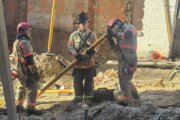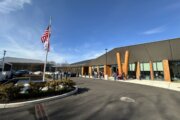The term scoliosis comes from the Greek word skolios, meaning curved or crooked, aptly describing the medical condition in which the spine curves sideways, often in an S or C shape. The condition typically develops during late childhood or early adolescence, when children undergo a period of rapid growth.
Discover what to do if you’re experiencing common scoliosis symptoms and the latest scoliosis treatment options available if you’re diagnosed with the condition.
[READ: How Poor Posture Can Harm Your Health.]
What Is Scoliosis?
The human spine is made up of a series of small bony structures, called vertebrae, that are joined together by soft tissues like cartilage, muscles, ligaments and tendons. This structure allows the spine to twist, bend, stretch and be flexible enough for all body movements.
Normally, the vertebrae and soft tissues grow in a vertical line when looked at from the front or back. However, scoliosis causes the spine to become curved and, sometimes, rotated like a corkscrew. When the spine appears as a C-shaped curve in the lower section of the spine, for example, it’s called lumbar scoliosis. In contrast, thoracic scoliosis, typically appears as an S-shape on the spine.
Types of scoliosis
There are three common types of scoliosis:
— Idiopathic scoliosis. The most common type of scoliosis, these cases account for about 80% of all cases and have no known cause. This version of the disease can affect kids at any age, but it’s most commonly diagnosed between the ages of 10 and 15, when children typically go through a major growth spurt. The spine grows into a side-to-side curve, usually in an S or C shape, and the vertebrae can twist or rotate. In many cases, the curve is small and stable, and it may not require treatment.
— Congenital scoliosis. This type of scoliosis is caused by a genetic anomaly that affects how the vertebrae develop during gestation. It may not become apparent until the child goes through a growth spurt around age 2 or in adolescence.
— Neuromuscular scoliosis. This is when scoliosis is related to another neurological condition or muscular disease, such as cerebral palsy, spinal cord trauma, muscular dystrophy, spinal muscular atrophy or spina bifida. Because this type of scoliosis often progresses faster than idiopathic and congenital scoliosis, it often requires surgical treatment.
How common is scoliosis?
Scoliosis affects an estimated 2% to 3% of people in the U.S., or about 6 to 9 million, mostly children. In general, there’s a much higher incidence in females than males, and females are eight times more likely to progress to a higher curve magnitude requiring treatment. However, it’s not known why scoliosis affects females at higher rates.
The majority of scoliosis cases are what’s known as idiopathic, meaning the cause is not known and not associated with a disease. Idiopathic scoliosis is characterized using four subcategories based on the age of onset: infantile, juvenile, adolescent and adult.
Is scoliosis genetic?
Yes, research indicates that scoliosis may be influenced by genetic factors, but experts have not yet identified the exact genes involved.
“We don’t have a specific genetic marker that is inheritable,” says Dr. Nicholas Anastasio, a board-certified physician specializing in physical medicine and rehabilitation at Orthopedics and Joint Replacement at Mercy Medical Center in Baltimore.
While scoliosis tends to run in families, experts believe that the condition is multifactorial and may involve an unknown combination of genetic, environmental, lifestyle and exposure factors.
[READ How to Fix Bad Posture]
Scoliosis Signs and Symptoms
According to the American Association of Neurological Surgeons, there are several signs of scoliosis:
— Shoulders are uneven, and one or both shoulder blades may stick out.
— Head is not centered directly above the pelvis.
— One or both hips are raised or unusually high.
— Rib cages are at different heights.
— Waist is uneven.
— The appearance or texture of the skin over the spine changes (dimples, hairy patches or color abnormalities may appear).
— The entire body leans to one side.
About one-fourth of patients with idiopathic scoliosis say they have back pain at the time of their first diagnosis, according to the AANS. Because scoliosis alters the size and shape of the chest cavity, it can also affect your health, including breathing, heart function and digestion.
Early detection is crucial, allowing for timely intervention and management of the condition to reduce the risk of progression. Left untreated, it can make all those conditions worse, and also further damage the spine and cause pain throughout adulthood.
[READ 15 Questions to Ask Your Orthopedic Surgeon During Your First Appointment]
Scoliosis Diagnosis
Pediatricians, as well as school-based health screeners, often use the Adam’s forward bend test for a preliminary screening to determine whether a child may have scoliosis. Using this standard screening test, the child stands with feet together and bends forward 90 degrees at the waist. A trained examiner can see any asymmetry in the body or any abnormal curves in the spine from this angle of view. However, it cannot determine what type of scoliosis it is or how severe it is.
Though this screening should be standard practice, not all providers will conduct a screening during a wellness exam, so don’t be afraid to ask if you notice signs of the condition. For parents or caregivers, it’s often noticed at an earlier age if your kid is involved in activities — like swimming, dance or gymnastics — when they’re in tighter clothing, says Dr. John Vorhies, a pediatric orthopedic surgeon and co-director of the Stanford Medicine Children’s Health Spine Center in Palo Alto, California.
On the other hand, it may go more easily unnoticed in colder weather climates, when children are wearing big, bulky clothing, or if a child is overweight.
The forward bend test can also be performed as an at-home scoliosis test to help parents check if their child may have any abnormalities in their spinal curvature. If parents notice any unusual traits after performing the test, they should follow up with their child’s pediatrician or primary care provider to confirm a diagnosis.
If a provider suspects scoliosis during screening, they’ll refer the individual to an orthopedic or neurological physician who can usually diagnose scoliosis with a physical examination, confirmed by an imaging study like an X-ray, spinal radiograph, CT scan or MRI.
The severity of the disease is determined by the degree of spinal curvature. This is most often measured with the “Cobb angle.” It’s the standard method for tracking the progression of scoliosis over time.
— Mild scoliosis. Any curvature greater than 10 degrees
— Significant scoliosis. In general, a curve above 25 to 30 degrees
— Severe scoliosis. Curves exceeding 45 to 50 degrees
[READ: Easy Lower Back Stretches for Pain Relief]
When to Treat Scoliosis
Small curves usually don’t cause problems and don’t need any treatment, though the curvature never goes away. If the curve is large, or if it gets worse, it can cause negative health consequences, including:
— Damage to the joints in the spine
— Arthritis of the spine
— Ribs may rub painfully against the pelvis and cause breathing, heart and digestive problems
If a patient has a larger curve and/or is still growing, the pediatrician, family physician or pediatric orthopedist should monitor the patient periodically for changes. If it becomes more severe, the child should be seen by a pediatric orthopedic surgeon to determine if treatment is necessary.
According to the Scoliosis Research Society, the following factors will determine the type of treatment recommended for idiopathic scoliosis in children and adolescents:
— Patient age and gender
— Bone age (the maturation of bone is not always the same as the chronological age)
— Degree of curvature
— Location of curve in the spine
— Status of menses/puberty
— Curve worsening
— Associated symptoms, such as back pain or shortness of breath
Scoliosis Treatment Options
There are three main treatment options for scoliosis:
— Observation
— Brace
— Surgery
Observation
If the spinal curve is mild, it may not require direct treatment, but the doctor may wish to keep a close eye on it and reexamine the child every three to six months to see if the curve worsens.
“If the curve is not progressing, there’s no treatment needed, it’s not going to cause any significant medical harm or even cosmetic deformation,” Anastasio says.
In the past decade, there has been an overall trend to reduce serial imaging (multiple follow up X-rays) and formal or invasive interventions.
Brace
Braces are only effective in patients who have not stopped growing and not yet reached skeletal maturity. If the child is still growing and his or her curve is between 25 degrees and 40 degrees, the doctor may prescribe a scoliosis brace to reduce the progression of the curve.
The AANS says improvements in brace design allow today’s braces to fit under the arm, not around the neck.
“Compliance is difficult, but if they comply, there’s well-established data that it will prevent progression,” Anastasio says.
Large studies reveal that braces, when used properly, successfully stop curve progression in about 80% of children with scoliosis. To work effectively, the brace may need to be worn 16 to 23 hours every day until the child stops growing.
While it can be hard for a child to think in terms of their future self and how wearing a brace will benefit them down the road, Vorhies recommends the following strategies:
— Personalized strategies. It may help to trick yourself into putting on your brace by tying it to an activity you’re already regularly doing in the day, like brushing your teeth.
— Mentorship. Some programs may facilitate connections between younger kids and an older child who has already been through the program to talk about their experience.
— A compliance app. This monitors use and reports how many hours per day the brace is worn to help with accountability.
Surgery
As a last resort, surgery is usually recommended only when the spinal curve is greater than 40 or 50 degrees and the disease is still progressing. The goal is to correct the curvature and stop its progression.
New advances in recent years continue to expand treatment options, including:
— Spinal fusion. The most common type of procedure is a spinal fusion, which is a type of orthopedic surgery intended to stabilize the spine and correct curvatures, though it can limit range of motion. The surgeon will fuse the vertebrae into a safer alignment by placing metal implants onto the spine that are then attached to rods, which hold the vertebrae in the corrected position until they fuse or knit together in one piece.
— Vertebral body tethering. A relatively new treatment approach, VBT received Food and Drug Administration approval in 2019 for treatment of idiopathic scoliosis. The procedure is intended to correct the curvature of the spine as the individual continues to grow, helping them maintain a fuller range of motion compared with a spinal fusion procedure. It involves a tether, connected to anchors and body screws placed in the vertebra in the curved section of the spine.
— Posterior dynamic correction. Also approved by the FDA in 2019, this device acts as an internal spinal brace. It’s an expandable rod that attaches to the spine using screws.
When considering surgical options, Vorhies emphasizes that it’s key to think beyond the immediate procedure and recovery time, and think about your long-term set of goals. Your pediatric orthopedic surgeon will work together with you to determine the best treatment options for your personalized goals.
For adults who were treated surgically with a spinal fusion 20 to 30 years ago, the AANS says there may be a need for revision surgery. In those days, surgeons fused long segments of the spine together. This put a lot of extra stress on the segments that were not fused, which led to a degeneration of those vertebrae and painful arthritis. Revision surgery can help lessen the load on the overworked parts of the spine.
Surgery in adults with scoliosis to correct spinal deformities isn’t taken lightly given that complications can be serious and even life-threatening — including infections, neurological problems, spinal imbalance and severe blood loss. Complications occur more frequently as procedures get more complex. Given that, experts recommend trying other more conservative approaches like physical therapy first, especially with mild symptoms, or to try to address symptoms a person can live with even if uncomfortable.
Alternative therapies
Growing evidence supports that physiotherapeutic scoliosis-specific exercises, or PSSEs, may help improve quality of life and stabilize spinal deformity. Although physical therapy is unlikely to reverse or progress curvature of the spine, it is increasingly recognized as an important component of comprehensive scoliosis care, as it can help strengthen and stabilize muscles that support the spine.
“Physical therapy generally is safe and typically would not be harmful to the patient,” Anastasio says.
With physical therapy, the muscles targeted are going to depend on the location of the curve, which is generally the paraspinal muscles, the long muscles that run up and down your back alongside the spine.
More from U.S. News
Health Questions to Ask Your Doctor
Preparing Your Body for Surgery: How to Improve Recovery
A Patient’s Guide to Scoliosis: Causes, Symptoms and Treatments originally appeared on usnews.com
Update 11/18/24: This story was previously published at an earlier date and has been updated with new information.







